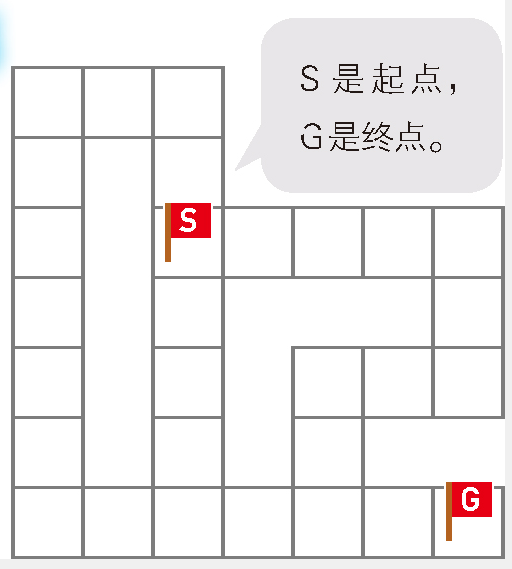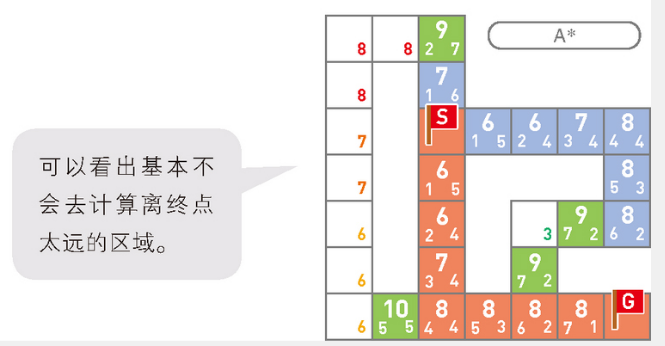缘起
最近阅读<<我的第一本算法书>>(【日】石田保辉;宫崎修一)
本系列笔记拟采用golang练习之
A*(A-Star)算法
A*(A-Star)算法也是一种在图中求解最短路径问题的算法,由狄克斯特拉算法发展而来。A*算法不仅会考虑从起点到候补顶点的距离,还会考虑从当前所在顶点到终点的估算距离。距离估算值越接近当前顶点到终点的实际值,A*算法的搜索效率也就越高.当距离估算值小于实际距离时,是一定可以得到正确答案的.A*算法在游戏编程中经常被用于计算敌人追赶玩家时的行动路线等.摘自 <<我的第一本算法书>> 【日】石田保辉;宫崎修一
场景
如下图, 某游戏中, 地图是网格状的, 我方在S点, 敌人在G点, 空白区域是湖泊/树林等不可到达区域:
现在需要追击敌人, 因此需要计算S点到G点的最短行进路线.
A*算法是以狄克斯特拉算法为基础, 区别是在计算候选节点的权重时, 需要同时考虑测量权重和估算权重.
此场景中, 使用S点到G点坐标的直线距离作为估算权重.
估算权重的作用就像牵引风筝的绳子, 使得每次选取的候选节点, 尽量是靠往终点方向.
流程
- 给定若干顶点, 以及顶点间的若干条边, 寻找从指定起点srcNode到指定终点dstNode的最小权重路径
- 设定srcNode的权重为0, 其他顶点的权重为无穷大
- 计算所有节点到dstNode节点的估算距离, 以x,y坐标的直线距离作为估算值
- 节点.总权重 = 节点.测量权重 + 节点.估算权重
- 将srcNode节点送入候选堆
- for 候选堆不为空:
- 从候选堆pop顶点node, node是总权重最小的候选节点
- 如果node.id == dstNode.id, 循环结束
- 遍历从node出发的所有边, 将边的终点to的测量权重, 更新为min(to.测量权重, node.测量权重+边.权重)
- 如果to.测量权重 > node.测量权重+边.权重, 说明更新有效
- 如果更新有效, 判断to是否在堆中, 如果是, 则上浮以维护堆秩序, 否则, 将to节点push入候选堆
- 判断dstNode的测量权重是否被更新(!=无穷大), 如果是则说明存在最短路径
- 反向查找最短路径:
- 设定当前节点current = 终点
- push节点current进路径队列
- 遍历终点为current的边, 查找符合条件的node:边的起点.测量权重 = current.测量权重-边.权重
- push节点node进路径队列
- 循环1-4, 直到current == srcNode, 查找完成
设计
- INode: 顶点接口, 支持xy坐标和估算权重
- ILine: 边接口
- IPathFinder: 最短路径查找算法接口
- IComparator: 顶点比较接口
- IHeap: 顶点堆接口
- tNode: 顶点, 实现INode
- tLine: 边, 实现ILine
- tNodeWeightComparator: 基于权重的顶点比较器, 实现IComparator接口
- tArrayHeap: 堆的实现
- tAStarPathFinder: A*算法的实现, 使用xy坐标的直线距离作为估算权重
单元测试
a_star_finder_test.go
package graphimport ("fmt""strings""testing")import astar "learning/gooop/graph/a_star"func Test_AStarFinder(t *testing.T) {fnAssertTrue := func(b bool, msg string) {if !b {t.Fatal(msg)}}// 设定顶点nodes := []astar.INode {astar.NewNode("11", 1, 1),astar.NewNode("21", 2, 1),astar.NewNode("31", 3, 1),astar.NewNode("12", 1, 2),astar.NewNode("32", 3, 2),astar.NewNode("13", 1, 3),astar.NewNode("33", 3, 3),astar.NewNode("43", 4, 3),astar.NewNode("53", 5, 3),astar.NewNode("63", 6, 3),astar.NewNode("73", 7, 3),astar.NewNode("14", 1, 4),astar.NewNode("34", 3, 4),astar.NewNode("74", 7, 4),astar.NewNode("15", 1, 5),astar.NewNode("35", 3, 5),astar.NewNode("55", 5, 5),astar.NewNode("65", 6, 5),astar.NewNode("75", 7, 5),astar.NewNode("16", 1, 6),astar.NewNode("36", 3, 6),astar.NewNode("56", 5, 6),astar.NewNode("17", 1, 7),astar.NewNode("27", 2, 7),astar.NewNode("37", 3, 7),astar.NewNode("47", 4, 7),astar.NewNode("57", 5, 7),astar.NewNode("67", 6, 7),astar.NewNode("77", 7, 7),}// 为相邻点创建边var lines []astar.ILinemapNodes := make(map[string]astar.INode, len(nodes))for _,it := range nodes {k := fmt.Sprintf("%v,%v", it.GetX(), it.GetY())mapNodes[k] = it}for _,it := range nodes {if up,ok := mapNodes[fmt.Sprintf("%v,%v", it.GetX(), it.GetY() - 1)];ok {lines = append(lines, astar.NewLine(it.ID(), up.ID(), 1), astar.NewLine(up.ID(), it.ID(), 1))}if down,ok := mapNodes[fmt.Sprintf("%v,%v", it.GetX(), it.GetY() + 1)];ok {lines = append(lines, astar.NewLine(it.ID(), down.ID(), 1), astar.NewLine(down.ID(), it.ID(), 1))}if left,ok := mapNodes[fmt.Sprintf("%v,%v", it.GetX()-1, it.GetY())];ok {lines = append(lines, astar.NewLine(it.ID(), left.ID(), 1), astar.NewLine(left.ID(), it.ID(), 1))}if right,ok := mapNodes[fmt.Sprintf("%v,%v", it.GetX()+1, it.GetY())];ok {lines = append(lines, astar.NewLine(it.ID(), right.ID(), 1), astar.NewLine(right.ID(), it.ID(), 1))}}// a*算法 查找最短路径ok,path := astar.AStarPathFinder.FindPath(nodes, lines, "33", "77")if !ok {t.Fatal("failed to find min path")}fnPathToString := func(nodes []astar.INode) string {items := make([]string, len(nodes))for i,it := range nodes {items[i] = fmt.Sprintf("%s", it)}return strings.Join(items, " ")}pathString := fnPathToString(path)t.Log(pathString)fnAssertTrue(pathString == "33(0+6) 34(1+5) 35(2+4) 36(3+4) 37(4+4) 47(5+3) 57(6+2) 67(7+1) 77(8+0)", "incorrect path")}
测试输出
$ go test -v a_star_finder_test.go=== RUN Test_AStarFindera_star_finder_test.go:96: 33(0+6) 34(1+5) 35(2+4) 36(3+4) 37(4+4) 47(5+3) 57(6+2) 67(7+1) 77(8+0)--- PASS: Test_AStarFinder (0.00s)PASSok command-line-arguments 0.002s
INode.go
顶点接口, 支持xy坐标和估算权重
package a_startype INode interface {ID() stringGetX() intGetY() intSetX(int)SetY(int)SetEstimatedWeight(int)SetMeasuredWeight(int)GetMeasuredWeight() intGetTotalWeight() int}const MaxWeight = int(0x7fffffff_00000000)
ILine.go
边接口
package a_startype ILine interface {From() stringTo() stringWeight() int}
IPathFinder.go
最短路径查找算法接口
package a_startype IPathFinder interface {FindPath(nodes []INode, lines []ILine, from string, to string) (bool,[]INode)}
IComparator.go
顶点比较接口
package a_startype IComparator interface {Less(a interface{}, b interface{}) bool}
IHeap.go
顶点堆接口
package a_startype IHeap interface {Size() intIsEmpty() boolIsNotEmpty() boolPush(node interface{})Pop() (bool, interface{})IndexOf(node interface{}) intShiftUp(i int)}
tNode.go
顶点, 实现INode
package a_starimport "fmt"type tNode struct {id stringx inty intmeasuredWeight intestimatedWeight int}func NewNode(id string, x int, y int) INode {return &tNode{id,x, y, MaxWeight,0,}}func (me *tNode) ID() string {return me.id}func (me *tNode) GetX() int {return me.x}func (me *tNode) GetY() int {return me.y}func (me *tNode) SetX(x int) {me.x = x}func (me *tNode) SetY(y int) {me.y = y}func (me *tNode) SetEstimatedWeight(w int) {me.estimatedWeight = w}func (me *tNode) SetMeasuredWeight(w int) {me.measuredWeight = w}func (me *tNode) GetMeasuredWeight() int {return me.measuredWeight}func (me *tNode) GetTotalWeight() int {return me.estimatedWeight + me.measuredWeight}func (me *tNode) String() string {return fmt.Sprintf("%s(%v+%v)", me.id, me.measuredWeight, me.estimatedWeight)}
tLine.go
边, 实现ILine
package a_startype tLine struct {from stringto stringweight int}func NewLine(from string, to string, weight int) ILine {return &tLine{from,to,weight,}}func (me *tLine) From() string {return me.from}func (me *tLine) To() string {return me.to}func (me *tLine) Weight() int {return me.weight}
tNodeWeightComparator.go
基于权重的顶点比较器, 实现IComparator接口
package a_starimport "errors"type tNodeWeightComparator struct {}func newNodeWeightComparator() IComparator {return &tNodeWeightComparator{}}func (me *tNodeWeightComparator) Less(a interface{}, b interface{}) bool {if a == nil || b == nil {panic(gNullArgumentError)}n1 := a.(INode)n2 := b.(INode)return n1.GetTotalWeight() <= n2.GetTotalWeight()}var gNullArgumentError = errors.New("null argument error")
tArrayHeap.go
堆的实现
package a_starimport ("errors""fmt""strings")type tArrayHeap struct {comparator IComparatoritems []interface{}size intversion int64}func newArrayHeap(comparator IComparator) IHeap {return &tArrayHeap{comparator: comparator,items: make([]interface{}, 0),size: 0,version: 0,}}func (me *tArrayHeap) Size() int {return me.size}func (me *tArrayHeap) IsEmpty() bool {return me.size <= 0}func (me *tArrayHeap) IsNotEmpty() bool {return !me.IsEmpty()}func (me *tArrayHeap) Push(value interface{}) {me.version++me.ensureSize(me.size + 1)me.items[me.size] = valueme.size++me.ShiftUp(me.size - 1)me.version++}func (me *tArrayHeap) ensureSize(size int) {for ;len(me.items) < size; {me.items = append(me.items, nil)}}func (me *tArrayHeap) parentOf(i int) int {return (i - 1) / 2}func (me *tArrayHeap) leftChildOf(i int) int {return i*2 + 1}func (me *tArrayHeap) rightChildOf(i int) int {return me.leftChildOf(i) + 1}func (me *tArrayHeap) last() (i int, v interface{}) {if me.IsEmpty() {return -1, nil}i = me.size - 1v = me.items[i]return i,v}func (me *tArrayHeap) IndexOf(node interface{}) int {n := -1for i,it := range me.items {if it == node {n = ibreak}}return n}func (me *tArrayHeap) ShiftUp(i int) {if i <= 0 {return}v := me.items[i]pi := me.parentOf(i)pv := me.items[pi]if me.comparator.Less(v, pv) {me.items[pi], me.items[i] = v, pvme.ShiftUp(pi)}}func (me *tArrayHeap) Pop() (bool, interface{}) {if me.IsEmpty() {return false, nil}me.version++top := me.items[0]li, lv := me.last()me.items[0] = nilme.size--if me.IsEmpty() {return true, top}me.items[0] = lvme.items[li] = nilme.shiftDown(0)me.version++return true, top}func (me *tArrayHeap) shiftDown(i int) {pv := me.items[i]ok, ci, cv := me.minChildOf(i)if ok && me.comparator.Less(cv, pv) {me.items[i], me.items[ci] = cv, pvme.shiftDown(ci)}}func (me *tArrayHeap) minChildOf(p int) (ok bool, i int, v interface{}) {li := me.leftChildOf(p)if li >= me.size {return false, 0, nil}lv := me.items[li]ri := me.rightChildOf(p)if ri >= me.size {return true, li, lv}rv := me.items[ri]if me.comparator.Less(lv, rv) {return true, li, lv} else {return true, ri, rv}}func (me *tArrayHeap) String() string {level := 0lines := make([]string, 0)lines = append(lines, "")for {n := 1<<levelmin := n - 1max := n + min - 1if min >= me.size {break}line := make([]string, 0)for i := min;i <= max;i++ {if i >= me.size {break}line = append(line, fmt.Sprintf("%4d", me.items[i]))}lines = append(lines, strings.Join(line, ","))level++}return strings.Join(lines, "\n")}var gNoMoreElementsError = errors.New("no more elements")
tAStarPathFinder.go
A*算法的实现, 使用xy坐标的直线距离作为估算权重
package a_starimport "math"type tAStarPathFinder struct {}func newAStarPathFinder() IPathFinder {return &tAStarPathFinder{}}func (me *tAStarPathFinder) FindPath(nodes []INode, lines []ILine, srcID string, dstID string) (bool,[]INode) {// 节点索引mapNodes := make(map[string]INode, 0)for _,it := range nodes {mapNodes[it.ID()] = it}srcNode, ok := mapNodes[srcID]if !ok {return false, nil}dstNode,ok := mapNodes[dstID]if !ok {return false, nil}// 边的索引mapFromLines := make(map[string][]ILine, 0)mapToLines := make(map[string][]ILine, 0)for _, it := range lines {if v,ok := mapFromLines[it.From()];ok {mapFromLines[it.From()] = append(v, it)} else {mapFromLines[it.From()] = []ILine{ it }}if v,ok := mapToLines[it.To()];ok {mapToLines[it.To()] = append(v, it)} else {mapToLines[it.To()] = []ILine{ it }}}for _,it := range nodes {// 设置src节点的weight为0, 其他节点的weight为MaxWeightif it.ID() == srcID {it.SetMeasuredWeight(0)} else {it.SetMeasuredWeight(MaxWeight)}// 计算每个节点到dst节点的估算距离if it.ID() == dstID {it.SetEstimatedWeight(0)} else {it.SetEstimatedWeight(me.distance(it.GetX(), it.GetY(), dstNode.GetY(), dstNode.GetY()))}}// 将起点push到堆heap := newArrayHeap(newNodeWeightComparator())heap.Push(srcNode)// 遍历候选节点for heap.IsNotEmpty() {_, top := heap.Pop()from := top.(INode)if from.ID() == dstID {break}links, ok := mapFromLines[from.ID()]if ok {for _,line := range links {if to,ok := mapNodes[line.To()];ok {if me.updateMeasuredWeight(from, to, line) {n := heap.IndexOf(to)if n >= 0 {heap.ShiftUp(n)} else {heap.Push(to)}}}}}}// 逆向查找最短路径if dstNode.GetMeasuredWeight() >= MaxWeight {return false, nil}path := []INode{ dstNode }current := dstNodemaxRound := len(lines)for ;current != srcNode && maxRound > 0;maxRound-- {linkedLines, _ := mapToLines[current.ID()]for _,line := range linkedLines {from, _ := mapNodes[line.From()]if from.GetMeasuredWeight() == current.GetMeasuredWeight() - line.Weight() {current = frompath = append(path, from)}}}if current != srcNode {return false, nil}me.reverse(path)return true, path}func (me *tAStarPathFinder) distance(x0, y0, x1, y1 int) int {dx := x0 - x1dy := y0 - y1return int(math.Round(math.Sqrt(float64(dx * dx + dy * dy))))}func (me *tAStarPathFinder) reverse(nodes []INode) {for i,j := 0, len(nodes)-1;i < j;i,j=i+1,j-1 {nodes[i], nodes[j] = nodes[j], nodes[i]}}func (me *tAStarPathFinder) updateMeasuredWeight(from INode, to INode, line ILine) bool {w := me.min(from.GetMeasuredWeight() + line.Weight(), to.GetMeasuredWeight())if to.GetMeasuredWeight() > w {to.SetMeasuredWeight(w)return true}return false}func (me *tAStarPathFinder) min(a, b int) int {if a <= b {return a}return b}var AStarPathFinder = newAStarPathFinder()
(end)

